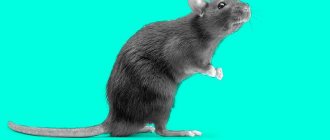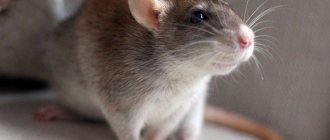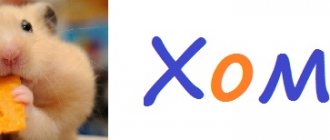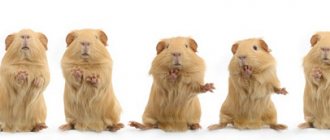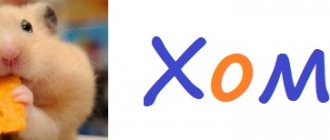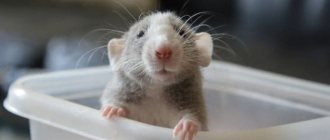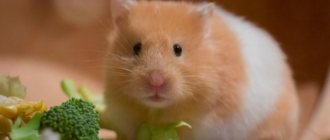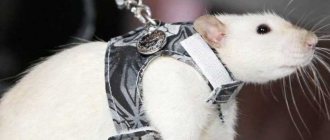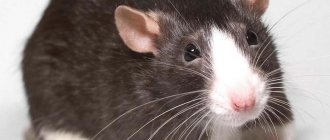Every rat owner sooner or later thinks about non-verbal ways of communicating with his pet. After all, understanding the body language with which an animal talks about itself is important for establishing contact with it and training.
We will find out what methods of communication rats use to transmit information to humans, we will analyze the basic gestures and sounds and their meanings.
Sounds, gestures and postures
Most pet rat owners are unaware that much of the communication between rodents occurs in the high frequency range. A person is able to catch only a small part of such a conversation.
The level of intellectual development of a rat is much higher than that of a hamster, mouse or guinea pig. Long-tailed rodents like to express their need for communication and emotional contact through gestures, sounds, and postures. For these animals, interaction with humans is much more important than with each other.
If the rat owner understands the meaning of at least some of the animal’s non-verbal signals, this greatly facilitates his contact with the pet.
Table 1. Basic signs of rat tongue
| Sounds | Gestures | Poses |
| Loud squealing, hissing (drives him away, protects his own) | A rat slightly bites a person, pulls his hair (good mood, invitation to play) | Boxer stance (challenge to confrontation) |
| Squeak (asks for help) | Licking (expression of love) | Sits on its hind legs, stretches its muzzle forward and upward, mouth slightly open (please give the item of interest) |
| A faint squeak, which is most often made by baby rats (the name is the mother) | Sharp jumping in place (the animal attracts attention) | Lying in a relaxed position, clicking his teeth (joy, satisfaction) |
| The rat clicks its teeth (the animal is calm, it is busy grinding its incisors) | Unexpected termination of the previous activity, followed by “washing” (the animal takes a break for a while to calm down) | The animal is slouched, its muzzle is raised high, its front legs are tense (the animal is ready for aggression) |
| Loud, long sound in a high range (the animal is in pain) | Unexpected light bite (sign of protest) | The animal is bristling, its fur is raised (it is cold or is experiencing stress). If an unblinking stare is added to the raised fur, the animal chews on the cage, hisses or makes a high-pitched vibrating sound, the rat is ready to attack. In such a situation, it is urgent to isolate the pet from other rodents. |
| The rat chatters its teeth, does not want to play, is lethargic (the animal is sick or confused) | The animal waves its front paws (attracts attention, or “denies”, asks to be left alone) |
Interesting! Decorative rats get sick due to reduced immunity. An animal that is experiencing moderate pain always tries to attract the owner's attention by tapping its teeth.
A feature of domestic rats is their emotional vulnerability. Animals absolutely cannot stand harsh shouts. A severe reprimand from the owner is enough for them to understand that they were wrong.
The pose of the rat is noteworthy, which means agreement with the offense: the animal is turned over on its back, feeling deeply guilty. Within the rat community, this is how individuals who break the rules are punished.
How to understand a rat?
Watch a rat for twenty minutes and the complex world of its character will open up to you.
If you want to buy an animal, watch how it communicates with its relatives, and you will understand whether it is a bully or calmly shares food with its comrades. Each rat has its own personality, but there are some common actions that all rats use to express happiness or displeasure. Once you learn to recognize them, it will become easier for you to understand your pet's complex nature.
Rats are social animals. They love to sleep cuddled up to each other, quarrel over crumbs, play and playfully fight. Your pet will feel happier with its relatives, even if you pamper it.
Rats generally trust their owners and actively seek their attention. This sets them apart from other small pets, such as hamsters, which tolerate human company rather than enjoy it.
After watching a group of cheerful, healthy rats, you will see how they lick and stroke each other's ears, fur, noses and tails. Mutual grooming is a manifestation of a warm relationship, a reminder of childhood and maternal affection. And you should know that if your rat starts licking your fingers or hair, then this is a compliment for you . She's trying to express how much she cares about you, not bite your finger off.
When rats are happy, they grind their teeth. This behavior is often compared to the purring of cats. You may not notice this quiet sound until your rat climbs onto your shoulder at ear level. This squeak causes a vibration that travels through the entire body, causing a slight trembling. This creaking noise, which expresses happiness, should not be confused with the clicking of teeth, which is a sign of excitement. Your pet's body language should tell you his state of mind.
If the fur on its back stands on end, or the whole body is tense, the eyes sparkle angrily and look at one point, then the rat is definitely excited about something. A rat may make squealing or hissing noises when attacked by another. If your rat shows anger towards another rat in the colony, move it to another cage and give it time to calm down.
Dominant rat. Typically, rats establish a hierarchy in their community in a playful manner. Add a new animal to the colony, and you will witness a whole performance. After sniffing and a short struggle, the weaker rat may find itself laid down on both shoulder blades. She will have no serious wounds, except for her wounded pride. The squeaks and squeals that you hear during such a “game” are simply exclamations of encouragement for yourself and intimidation of the enemy, and not manifestations of rage. Separate the rats if one bites the other hard enough to bleed.
It's important to take time to observe your pets every day so you can quickly recognize any antisocial behavior. If one of your pets seems lethargic, refuses food, or sits alone, there is probably something wrong with it. Contact a veterinarian who specializes in small mammals as soon as possible.
Copyright holder: Zoo Club portal When reprinting this article, an active link to the source is MANDATORY, otherwise, use of the article will be considered a violation of the Law on Copyright and Related Rights.
Nocturnal lifestyle
Wild rats are active at night, and during the day they rest in a shelter. Pets can be adapted to human routines, but this will require patience and focused training on the part of the owner. The best time for games and training is after 20:00.
Some owners of pet rodents communicate with the animals in the early morning. It all depends on the type of rat, its individual characteristics, and the degree of contact. If you do not work with the animal, the animal will sleep during the day.
Incorrect treatment of atopic dermatitis. 5 main mistakes
Atopic dermatitis is a chronic inflammatory skin disease that causes itchy red patches, rashes, peeling and dryness. This disease is diagnosed in 30% of children and 10% of adults. However, atopic dermatitis is often not given due attention, and incorrect treatment of this disease can slow down the onset of remission and worsen the overall level of health. Dermatologist Anna Trushina talks about the 5 most common mistakes in treatment tactics.
Mistake #1. Excessive diagnostics aimed at identifying “non-skin” causes.
The reasons for the development of atopic dermatitis lie in genetically determined features:
1. From the skin - associated with a violation of the barrier function.
2. From the immune system. In response to the penetration of irritants and allergens through a broken skin barrier, inflammation forms.
Therefore, it is not advisable to look for the cause in helminths, disturbances of intestinal microflora, intoxication, etc. The entire range of examinations prescribed in this regard only because of atopic dermatitis is not justified. Efforts aimed at finding the “root cause” outside the skin are better directed towards competent treatment of the skin itself.
Mistake #2. Search for the causative allergen.
Atopic dermatitis is not an allergic disease in nature. However, allergic reactions can be combined with atopic dermatitis as a concomitant disease. This happens in approximately 20-30% of patients.
Therefore, atopic dermatitis itself is not a reason to undergo expensive panels for specific allergens, and the test should only be taken if a specific allergic reaction is suspected in some patients.
Mistake #3. Following an unreasonable diet.
Often atopic dermatitis becomes the reason for prescribing a strict “hypoallergenic” diet. Children's diet becomes monotonous and boring. However, such dietary restrictions are not scientifically justified and do not bring the desired result, even if there is an allergy at the same time.
In addition to the lack of effect, a strict diet can harm the body. It leads to deficiencies of important nutrients, minerals and vitamins, which can negatively affect the overall health of the child. Therefore, children with atopic dermatitis need to eat a varied and balanced diet. Only those foods whose role has been clearly proven to aggravate the pathological process are excluded from the diet. Similar rules apply to the mother’s diet if the baby is breastfed.
Mistake #4. Irrational skin care.
The basis of the treatment of atopic dermatitis is the restoration of the skin barrier function and the elimination of inflammation. Therefore, products are prescribed that help HYDRATE and soften the skin and retain moisture inside it, and thereby improve the protective properties of the skin. The complex also uses measures that reduce the likelihood of developing an inflammatory process, i.e. skin contact with potential aggressors from the external environment is limited.
To achieve the goals listed above, careful and careful care of the skin of an atopic child using EMOLENTS is required. These are special products, lotions, creams, balms, which, when applied to the skin, soften and moisturize it, help fill the intercellular spaces in the skin, restoring its barrier properties.
It is important to understand that using simple baby creams 1-2 times a day may not be enough. Proper care requires the application of special emollients in sufficient quantities. They are distributed in a thick (!) layer on both problem and visually unchanged areas of the skin. At the same time, the frequency of application directly depends on the condition of the skin. It is necessary to use emollients so many times during the day that the skin remains smooth, soft and without flaking to the touch all day.
Mistake #5. Refusal of “hormones”.
With atopic dermatitis, an inflammatory process occurs inside the skin (the word “dermatitis” itself, literally translated into Russian, means inflammation of the skin). That is why during an exacerbation, anti-inflammatory external agents are used to stop the inflammation. These drugs include external glucocorticosteroids. However, many parents refuse these “hormones” due to steroidophobia (fear of using steroids).
Topical (i.e., used externally: lotions, emulsions, ointments, creams) corticosteroids have been used in the treatment of atopic dermatitis for decades. During this time, they have demonstrated high efficiency and a high safety profile.
If parents do not use corticosteroids in cases where there are indications for this, or do it irrationally (prescribed independently without taking into account the degree and form of skin inflammation, independently cancel the hormone before the required time without the supervision of a doctor), then this can lead to deterioration of the skin condition , the formation of foci of chronic inflammation and other local complications.
Scavenger hunt
The desire to create reserves, deeply rooted in the rat’s nature, sometimes leads tailed pranksters to the trash can. If the owner does not have the habit of closing the container with a lid and often lets the animal walk around the house on its own, he should be prepared for the inevitable - the animal will get into the habit of carrying objects from the trash heap.
Most rats will pick up and take back to their nest anything that can be chewed. These can be wooden, plastic, rubber objects, pieces of fabric. Rodents masterfully arrange stashes of food reserves; they are quite difficult to find. In order to have such closets, the animal must have a certain amount of time when the control of the owners is completely absent.
Fights
It has been noticed that rats can box. Typically, two adult males behave this way when they compete for hierarchical status in a rat community. The animals stand on their hind legs and strike each other with their forelimbs.
Researchers confirm that social pyramids are formed within rat clans, headed by alpha males. Fights in which animals measure their strength are typical for this type of rodent. Brawls can occur, for example, when an older young rat asserts its rights to the highest rank in the hierarchy.
Sometimes fights between rodents arise due to intrusion into someone else's territory. Animals jealously protect their habitat. If you add a new inhabitant to the cage of an old-timer rat and do not first introduce the animals in a separate area, a fight cannot be avoided.
Young rats, especially females, get used to newcomers most easily. With adult males the situation is much more complicated; in most cases they begin to measure their strength.
Character of decorative rats
Rats are social rodents
If you think that all rodents have the same character, and they are all carbon-copy similar to each other in their behavior, you are mistaken. Just as there are no absolutely two identical people, there are absolutely no two identical decorative rats. And, this applies not only to their appearance, but also to their inner world. There are general behavioral features characteristic of the species, but each decorative rat has its own character.
It is quite obvious that when you come to a pet store and want to choose a pet, you still don’t know anything about it or its character. In order for you to make a first impression (which, however, can also be wrong), we suggest that you spend a few minutes of your time observing the behavior of the rat in its usual environment. How does she behave with her relatives, how does she eat, is she constantly on the move or does she prefer to sit in the corner of the cage? All this will allow you to get at least a general idea of the character of your future pet.
Bites
Experienced breeders of decorative rodents know that you need to thoroughly wash your hands when interacting with animals. Rats are unusually sensitive to odors. They may mistake a hand that smells like food for the food itself and grab it tightly with their teeth.
If an animal slightly bites its owner, ruffles its hair, and quietly clicks, it means that the animal is in a good-natured mood and invites you to play. A rat that has adopted an aggressive posture may bite for real if you do not give it time to recover.
When a fight brews in a cage, bites are also inevitable. Therefore, when handling an animal that is experiencing stress, you need to wear thick gloves.
Posts 1 page 8 of 8
Share12013-04-23 21:01:31
- Author: Rattar
- Participant
- Registered: 2013-04-23
- Invitations: 0
- Posts: 3
- Spent on the forum: 21 minutes
- Last visit: 2013-05-03 22:17:14
In general, I think many will understand just by the name of the topic... I'm interested in the nature of the fact that a rat gets into its mouth for the purpose of, ahem... no matter how stupid it may sound - to drink drool. Well, I can’t believe that their kisses are like that, although it’s quite possible to think so. Why are they so drawn there, regardless of what the owner ate (one could attribute it to the aftertaste).. What are your options?
Share22013-04-23 21:31:16
- Author: runa
- Administrator
- From: Donetsk
- Registered: 2009-08-15
- Invitations: 0
- Messages: 20590
- Female gender
- Time spent on the forum: 6 months 7 days
- Last seen: Yesterday 18:39:09
mine are just trying to kiss, almost no one is drawn to saliva
Share32013-04-23 21:51:00
- Author: Rattar
- Participant
- Registered: 2013-04-23
- Invitations: 0
- Posts: 3
- Spent on the forum: 21 minutes
- Last visit: 2013-05-03 22:17:14
Well, maybe it’s like that, but in my case it gets into my mouth, sometimes even spreading my lips with my paws to get in there. Some kind of French kisses are obtained.
Share42013-04-23 21:54:02
- Author: markopolo83
- Moderator
- From: Donetsk
- Registered: 2012-05-30
- Invitations: 0
- Posts: 1422
- Female gender
- Age: 37 [1983-11-05]
- Spent on the forum: 1 month 8 days
- Last visit: 2019-11-07 16:00:52
Darwin climbed into my mouth a couple of times to take a piece of my lip with him. No one else showed interest in my lips.
Share52013-04-24 01:49:03
- Author: Tyrin
- Participant
- From: Kyiv
- Registered: 2011-08-29
- Invitations: 0
- Posts: 493
- Female gender
- Age: 28 [1993-06-05]
- Time spent on the forum: 12 days 3 hours
- Last visit: 2015-04-08 22:33:09
When my Rat starts biting, he first bites my face, then my lips. He opens his mouth with his paws and licks the inside of his lip, counting his teeth. Either licks it or bites it. And it doesn’t depend on whether I ate something or not. Hera only puts it in her mouth when she smells delicious. Hishi is not a kisser, he kicks away with his paws. and rats can drink saliva due to the lack of water in the cage or if they cannot reach it (for example, they sat on the owner’s shoulder for a long time).
Share62013-04-24 14:04:55
- Author: Rattar
- Participant
- Registered: 2013-04-23
- Invitations: 0
- Posts: 3
- Spent on the forum: 21 minutes
- Last visit: 2013-05-03 22:17:14
Yes, he does this even after just drinking from the drinking bowl.
Share72013-04-24 21:28:21
- Author: SunSprite
- Participant
- From: Donetsk
- Registered: 2011-06-08
- Invitations: 0
- Posts: 683
- Female gender
- Time spent on the forum: 11 days 19 hours
- Last visit: 2014-12-11 14:21:57
I'm both very kissable
They’ll climb right onto your shoulders and kiss you on both sides))
Share82013-04-25 00:12:56
- Author: Pach
- Participant
- From: Kyiv
- Registered: 2012-05-10
- Invitations: 0
- Posts: 731
- Spent on the forum: 10 days 11 hours
- Last visit: 2019-11-17 13:00:58
In general, this is a wonderful way to find out what the owners ate without them.
Source
Moustache wiggling
Rat whiskers are sensitive antennas that help animals navigate in space. The information that rodents receive with the help of such a navigator is so detailed that the animals not only move confidently in the dark, but also receive an almost complete understanding of the surrounding objects, including the features of their dynamic trajectory.
When a rat moves its whiskers, it not only explores odors, collects information about the world around it, but also maintains the balance of movement. It is with its sensitive whiskers that the animal first of all checks unfamiliar objects, including the palms of people.
Teeth grinding
This phenomenon usually accompanies the bulging of the eyes described above. There is no need to be scared, the rat belongs to the rodent family, and its teeth are constantly growing. When a rat grinds its teeth, it tries, so to speak, to moderate their growth, to make sure that they do not grow too quickly. Moreover, teeth grinding in rats is similar to purring in cats - this is what they do in moments of relaxation and peace. This creates vibrations that help the eyeball protrude - therefore, these two phenomena are interrelated. At the same time, a rat may grind its teeth when it is scared or in pain, so pay attention to the circumstances under which this happens (for example, when you pet it or vacuum near the cage).
Original publication: 10 Common Rat Behaviors. Author: Laura Doering.
Tail movements
One of the main indicators of a rat’s mood is the “behavior” of its tail. An attentive observer will be able to accurately determine the emotional state of his pet if he pays attention to the longest part of his body.
Table 2. How to decipher rat tail movements.
| Nature of movement | What does it mean |
| Lightly swings left and right | The rat is in good spirits, glad to see the owner |
| The tail twitches or freezes in a static position, often quite unnatural | Anxiety, defensiveness |
| Swings in both directions, range of motion is quite large | The animal is stressed and very scared. Perhaps the animal is in an inadequate condition |
The behavior of rats in the search mode differs significantly from their behavior in a calm state. At the same time, sick animals can be distinguished by slow movements and a “lifeless” tail dragging along the floor.
A healthy rat is usually very curious. She enjoys exploring her surroundings. If a rodent is interested in something, it usually rises on its hind legs and sucks in air through its nose. The rat's tail is slightly tense and sometimes motionless.
The animal can enthusiastically turn its head while searching for an interesting object. In this state, the rat turns on all external analyzers, examines visible objects, sounds, and smells.
LEARNING TO UNDERSTAND THE LANGUAGE OF RATS
Just 20 minutes of reading and you will better understand the character of your rat. If the rat you are going to buy communicates with other rats of its age, then you will see whether it is a local bully or is happy to share food with others. You will understand that every rat is an individual, but there are also some behavioral characteristics that can help you understand the rat's language of happiness or sadness. Understanding a rat's language is as easy as deciphering its behavior and signs.
Rats are social animals Rats are very social. They love to sleep in a single ball, compete for treats and just go crazy together. Your pet may be happier with other rats, although most rats love to interact with people. They have learned to trust people and constantly seek communication with them. This is what sets them apart from other small animals, such as hamsters, which tend to treat people with indifference rather than affection. If you hang out with a happy, healthy group of rats, you will find them licking and grooming each other's ears, fur, noses and tails. General grooming shows the rats’ good relationship with each other, a reminder of youth and the mother rat caring for her babies. Grooming rats are happy animals, and you should take it as a compliment if your rat starts licking or grooming your fingers or hair during quiet time together. The rat is trying to woo you, not bite your hand. Rats grind their teeth when they are happy. Rats may also grind their teeth when they are happy. This behavior is most often called rat purring, i.e. the same as a cat purring. At first, you may not hear such purring until the rat climbs onto your shoulder at ear level. When a rat purrs, it may seem that the vibration is going throughout its entire body. But purring should not be confused with warning sounds when rats are aggressive towards each other. I think that depending on the situation you can determine whether your rat is aggressive or not.
Bulging eyes
Some owners of decorative rodents begin to worry about their pets if their eyes protrude forward. As a rule, this occurs during grinding of teeth.
Experts advise not to attach importance to the bulging eyes of a rat that is sharpening its incisors. After all, after the end of the process, the appearance of the animal becomes the same.
Interesting! Most often, the bulging eyes of a rat indicate a good mood of the animal.
